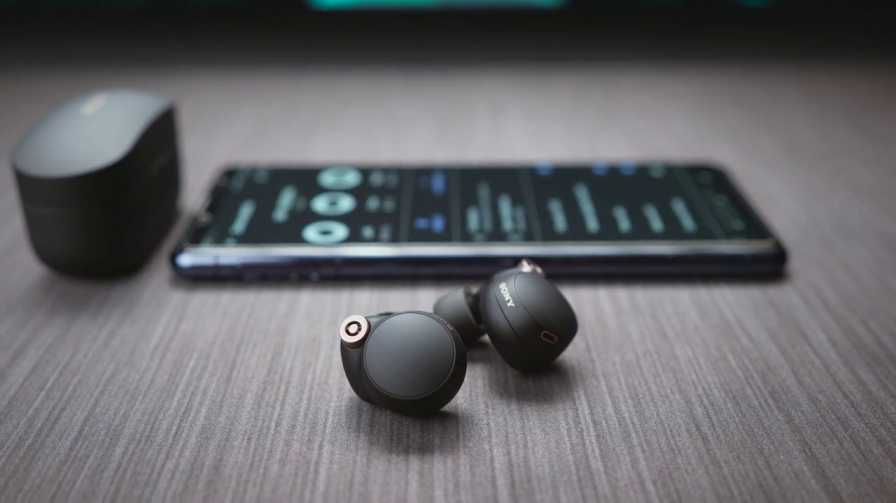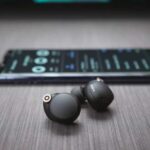Sony WF-1000XM5 Earbuds
Conservative Japanese have not changed the design of their Sony Xperia smartphones for years. But with headphones, it is much more interesting: that the Sony WH-1000 overheads, that the WF-1000 “plugs”—each new generation is different from the previous one.
So it is in the Sony WF-1000XM5: the body has become lighter and more compact, and the headphones themselves are much smaller. Now black “capsules” do not protrude from the ear, like a headset of the 2000s, but are elegantly hidden in the ears. Although they lost their charisma, the chubby Sony WF-1000XM4
stood out from the competition with its brutality and copper-coloured inserts.
Part of the surface is made of glossy plastic, which collects stains and scratches. But in practice, you don’t notice it; you take it out and stick it in your ears. Who’s going to be watching? What else is the gloss scolded for? The headphones are hard to pick out of the case. Everything is individual here. Huawei FreeBuds Pro was also scolded by many for this, but I had no problems.
The Sony WF-1000XM5 is protected from moisture according to the IPX4 standard; you can play sports, and sweat is not terrible. The kit includes SS-size nozzles—super small, very small. The pleas of girls and people with miniature ears in general are heard.
Sony WF-1000XM5 on the left, AirPods Pro 2 on the right
The ear pads are made of the same polyurethane foam as the Sony WF-1000XM4. And this is both good and bad. Pros of foam:
- The headphones fit snugly in the ear.
- Do not fly out when shaking.
- Do not slip from sweat.
- You hear less extraneous noise.
Cons of foam:
You feel the headphones all the time, especially when moving.
Sometimes there is an acute desire to pull out and take a break from them.
For better sound insulation, you have to screw in the headphones and look for the ideal position in the sink.
Personally, I never got used to the foam ear pads. The AirPods Pro 2 and Nothing Ear (2) are much more comfortable for me. In the first, I spend 4-5 hours in a row on flights and do not take it out of my ear at all. Sometimes I even forget about them. I use the second ones in the gym, and I have not encountered the problem of slipping from sweat.
By the way, for the Sony WF-1000XM5 provided for review, we thank our friends.
Connect and Control
Perhaps the weakest point of the Sony WF-1000XM5 relative to competitors But let’s start with the pros. You can easily connect the headphones to any equipment with Bluetooth. Finally, Sony did it in a human way, like everyone else: you need to hold down the button on the case and not hold your finger on one earphone. It has become much more convenient. Bold like.
Multipoint is supported; you can connect to two devices and switch between them. When you remove the earbud from your ear, playback pauses. Works perfectly.
But the strategy of “doing everything like everyone else” touched on a cool feature of the Sony WF-1000XM4: a large indicator of charge and connection. A wide, bright strip has degenerated into a tiny dot. Under the bright sun, the status of the headphones is not always visible.
Okay, little things. That’s not a trifle, so it’s ease of management. Namely, changing the volume. Sony offers to quickly press the sensor on the headphone case four (four, Carl!) times while the volume is reduced by ~ 5%. And you, like a fool, tap the Morse to make it quieter or louder. As a result, you give up and reach into your pocket for the phone.
I liked the compromise in the Nothing ear (2): press and hold the left earbud; the volume quickly decreases until you let go. Right earbud: the volume increases. Relatively convenient. But ideally, of course, in AirPods Pro 2 and Huawei FreeBuds Pro: just “stroke” the leg with your fingers up and down, and the volume changes.
If you have an Android smartphone, the connection is simple: hold down the button on the Sony WF-1000XM5 case, and an offer will appear on the screen with a quick connection of headphones, thanks to the Fast Pair technology.
With Apple technology, “magic” does not work; you need to go into the Bluetooth settings. And the headset did not make friends with the MacBook at all on the first attempt, and during operation, the sound was disgusting. The MacBook and Sony WF-1000XM5 aren’t made for each other at all; keep that in mind. Or check the connection before buying; perhaps when you read this review, the problem is solved.
A rare beast with LDAC support
Sony has installed a new V2 processor in the WF-1000XM5, which is responsible for the entire “smart” part. There is also a new large driver with a diameter of 8.4 mm, versus 6 mm in the last generation. However, judging the sound by the size of the drivers is a lost cause. For example, in the first generation of AirPods Pro, the diameter is 11 mm, and they sound disgusting.
The main advantage of the Sony WF-1000XM5 is support for LDAC and LC3 codecs. LDAC allows you to transfer data at speeds up to 990 kbps—three times faster than the AAC that is on the iPhone. Download music in uncompressed format and listen to it in its original quality.
LDAC mode works with Android smartphones. Someone does not feel the difference; for someone, LDAC support is critically important; this is a reason to buy specifically the Sony WF-1000XM4 or XM5. Especially now in Russia, when a lot of foreign music has disappeared on streaming services and listeners download tracks in less legal ways. So why not download it in an uncompressed format like FLAC right away?
If you have an iPhone, it doesn’t concern you. It does not support such an audio bit rate. Standard codecs are used, so you will not hear “hidden” details even in uncompressed tracks.
In terms of sound quality, the Sony WF-1000XM4 evokes only pleasant impressions. Excellent detail, good frequency study, the volume is felt, and the volume is large. There is not enough saturation of low frequencies and bass.
The same claims were made about the Sony WH-1000XM5 overheads. As if in the fifth generation, the Japanese focused on details and moved away from the trademark dense bass. Equaliser to help, you can get confused and squeeze out the perfect quality. But even the AirPods Pro 2 and Noting ear (2) out of the box are beautifully tuned and sound balanced.
Noise Cancellation, Transparency Mode, Microphones
The V2 processor is also responsible for active noise cancellation (ANC). There are many modes of operation available; if you turn on the most killer, extraneous sounds will disappear completely. It’s like you’re climbing into your quiet, cosy bubble. Naturally, the plane is on takeoff, and the old subway cars—these loud guys—will get to your eardrums. Compared to the Sony WF-1000XM4, the difference is barely distinguishable.
In 2023, many headphones with excellent ANC came out; Sony’s gap in this regard is no longer so noticeable. But still, these are some of the best wireless headphones with active noise cancellation.
The transparency mode has also not changed much compared to the previous generation. Your voice seems muffled and distant, and the surrounding sounds are much quieter than in reality. This is where AirPods Pro 2 win.
As for the quality of the microphones, the Sony WF-1000XM5 and AirPods Pro 2 are on the same level. The former sound is more booming, but it better suppresses extraneous noise. In both cases, the interlocutors will hear you well. I left examples of records for comparison here.
The app is oversaturated.
You can control Sony headphones through the proprietary Headphones Connect application. Updates also arrive here; new chips appear. This year is a beta version of the Find Your Equaliser feature. What it looks like:
- You play any song;
- The app gives you multiple sound options.
- You choose the best one for you.
- This is repeated 4-5 times.
- The settings are saved as a custom preset.
The function did not help me: after 5 laps of selection, it turned out that I prefer a sound with slightly raised bass and high frequency. The difference is negligible, and in the end, I still returned to the original settings. But you may have better luck.
We’ve already seen other clever features. For example, switching modes of operation by geolocation Or when you start talking to someone, the system turns off noise reduction and turns on the transparency mode.
But in fact, the geolocation is not always determined accurately, and the mode may not change in the designated place. Or the headphones incorrectly detect ambient noise: in the Sony WF-1000XM5 office, they think that this is a “transport” and turn on noise cancellation to the maximum. Coughing and laughing are perceived as conversations, so turn on the transparency mode, although you are not going to talk to anyone.
These chips are pleasantly shocking to a beginner. Wow, what smart headphones I bought! But you quickly realise that it works from time to time; more often than not, it only interferes. And as a result, you cut down on intellectual modes. Even DSEE Extreme, an enhancement to compressed MP3 tracks, doesn’t always work well and can make the sound worse.
The Monster of Autonomy
Sony claims up to 8 hours of operation of the Sony WF-1000XM4 with noise cancellation on and up to 12 hours with it off. In fact, even more. This is above average among competitors. During all the testing, I did not have a scenario for the headset to discharge to zero, and it is unlikely that you will.
After all, even 3 minutes of staying in the case is enough for the Sony WF-1000XM4 to work for another hour. What is 3 minutes? Go to the toilet, make coffee, and pet the cat. Underline the necessity. I threw it into the case and returned it; you still have an “extra” hour of work. Competitors need 5 minutes. It seems nonsense, but sometimes ultra-fast charging helps out a lot.
Wireless charging is located at the base; the case is charged “standing”. From zero to 100%, the process takes 1.5 hours. Wired charging is via the USB-C port.
theinquisitivemeeple.com Opinion
If the full-size Sony WH-1000XM5 caused more negative emotions, then there are fewer complaints about updating the Sony WF-1000XM5 plugs. The case and headphones have become more compact, look good, and fit snugly in the ears. Noise cancellation and microphone performance are at the highest level. Sound-wise, too, this is the best TWS headset to work in conjunction with Android smartphones.
However, keep the cons in mind before buying. Foam ear pads are not for everyone. Ears can get tired quickly and even hurt. The bass here is not as powerful as in the Sony WF-1000XM4. Volume control is implemented inconveniently.
The conclusion is very simple: if you have an Android smartphone and a lot of money, take the Sony WF-1000XM5. You will not regret it. Just first try to determine whether it will be convenient with the “foam”. If you have the previous generation WF-1000XM4, you can also upgrade, especially if you get the large size of the “four”.
But if you have Apple devices—first of all, the iPhone—take the AirPods Pro 2. The second generation is better than the first in everything; there is excellent sound, noise reduction, and perfect transparency mode, and they fit perfectly in the ears. So you also get ecosystem chips—quick connection and switching, convenient volume control.










